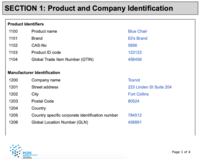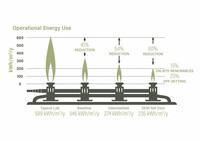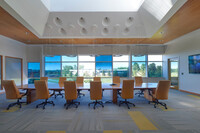News Brief
Cirrus Low Carbon offers a sweeter deal on C-PACE loans for commercial projects verified to achieve high-performance design specifications.
The Commercial Property Assessed Clean Energy loan program (C-PACE) offers low-interest capital to projects pursuing energy and water savings; the loan gets paid back through a special tax assessment. Pretty good deal, but the New Buildings Institute (NBI) and PACE Equity have teamed up to make it even better.
Project teams committing... Read more
News Brief
A new concrete rule from GSA and energy code adoption from DOE continue U.S. efforts to curb both embodied and operational carbon.
The Biden administration has released new procurement rules—one focused on embodied carbon and the other on operational carbon—affecting all federal government building projects.
The U.S. General Services Administration (GSA) will require concrete to meet newer, more stringent requirements.... Read more
Op-Ed
USGBC responds to an earlier op-ed, “LEED Must Lead on Climate.”
Contributed by these guest authors:
Lance Davis, Federal Agency Sustainability Architect and chair of the LEED Steering Committee; Melissa Baker, SVP, LEED Technical Development, U.S. Green Building Council; and Laurie Kerr, FAIA, Principal Climate Advisor, U.S. Green Building Council
Earlier this week, BuildingGreen ran an op-... Read more
Op-Ed
The world urgently needs the building industry to tackle climate change, and LEED has to be part of that.
Contributed by these guest authors:
Greg Kats, Kevin Hydes, Anica Landreneau, Gunnar Hubbard, Vivian Loftness, Rob Watson, Mark MacCracken, Anthony Bernheim, Dan Burgoyne, Doug Farr, and David Gottfried
LEED, the great global green building design standard, has failed to adequately respond to climate change. The program—... Read more
Product Review
Choosing interior acoustic products that contain fewer hazardous materials will improve the overall interior environmental quality without compromising designs.
Controlling excessive interior sound is critical for creating a warm, welcoming space. This can be particularly important in low-embodied-carbon interiors that use structure as finish, such as polished concrete floors or exposed beams—materials that do not absorb sound well.
There are a variety of... Read more
News Brief
A new white paper dives into continuous air-quality monitoring, helping make the technology and practices accessible to more projects.
Good indoor air quality is vital to sustainable building, but accomplishing it—and verifying that you’ve done so—is not easy. “Considerations for Continuous Air Quality Monitoring: Simple tips for getting it right, according to IAQ consultants” is a free white paper, written by members of the BuildingGreen Peer Networks,... Read more
News Analysis
From an architecture office to a children’s museum, this year’s projects went above and beyond to bring stakeholders into the fold.
The Committee on the Environment (COTE) of the American Institute of Architects has unveiled its annual top ten awards for high-performance projects. This year’s winning project teams—everything from schools to public works facilities—went all in on community engagement to help ensure occupant satisfaction, appropriate... Read more
Webcast
Can you demonstrate both environmental and health performance in a meaningful way?
USGBC and IWBI are beginning to see eye to eye across a range of focus areas. Knowing how to leverage each in a mutually beneficial way is the key to driving successful integration of a dual certification approach.
Join LEEDuser’s special guest,... Read more
News Brief
Toxnot is offering a new way to track product ingredients and other circular design features.
Can you reuse it? Can you take it apart and make something new? Can you safely recycle it? The Product Circularity Data Sheet (PCDS) is designed to answer questions like these about building products.
First developed in Luxembourg, the PCDS not only lists product constituents, something like a health... Read more
News Brief
Returning to the office means ensuring occupant health, but a recent study published in PLOS Water highlights the hazards of water that has sat in plumbing for too long.
So you’ve been working remotely for a while and are thinking about returning to the office soon. Before you get your first drink or make that first pot of coffee, you’ll want to make sure the water is actually clean. According to a recent study in the journal PLOS Water, stagnant water can have significant impacts on water quality after sitting... Read more
News Analysis
Language matters. Now there are standardized ways to write embodied carbon limits into both building codes and architectural specifications.
Aspirational limits on embodied carbon in our buildings are all well and good, but how do you actually determine and implement those limits? New code language and a new model specification could be the ticket.
NBI petitions for code inclusionThe New Buildings Institute (NBI) has developed and submitted code language that it hopes will... Read more
News Brief
HOK has released a study showing how to slash both operational and embodied carbon when designing new labs.
Laboratories are notorious energy hogs. They also tend to have high embodied carbon when built new. Reining in the carbon footprint of this booming building type will be necessary in order to reach the net-zero-carbon goals of both the American Institute of Architects’ and the Royal Institute of British Architects’ respective 2030 Challenges.... Read more
News Brief
The American Institute of Architects has chosen five sustainability research projects to fund through its Upjohn Research Initiative.
The American Institute of Architects (AIA) has announced five research projects that will receive funding through the Upjohn Research Initiative. All of this year’s projects are designed to promote climate action.
Architects and Grid-Interactive Efficient Buildings (GEBs): The Role of the Profession in the Emerging Field of GEBsGrid-... Read more
News Analysis
Demand for mass timber is going up, but there’s still lots of room to grow. Can that happen—sustainably—in today’s market?
Mass timber—especially cross-laminated timber (CLT)—has captured the imagination of designers across North America. From biophilia to jobsite safety to the promise of ultra-low embodied carbon, this relatively new structural material has made its way into the International Building Code (IBC) and the National Building Code of... Read more
Feature
Electrochromic glazing holds the promise of less glare and better energy efficiency with fewer attachments. The reality is much more complicated.
The sun streaming into our buildings can be both a benefit and a nuisance. Controlling its glare and solar heat gain in order to maximize energy efficiency, occupant comfort, and views to the outdoors is difficult. In commercial offices and all-glass buildings, the impacts are multiplied. Low-e glazing and exterior or interior shading systems... Read more
April Fools
The Intergovernmental Panel on Climate Change released part two of its Sixth Assessment Report in February—but it left out some strong feelings.
The Intergovernmental Panel on Climate Change (IPCC) has come under fire due to a leaked draft of part two of its Sixth Assessment Report (AR6). The formerly secret document reveals that the panel’s first attempts to analyze climate change impacts had devolved into a... Read more
April Fools
The Beacon of Hope, which once held the promise of making buildings and humanity better, has had to shut down due to problems with its artificial intelligence platform.
Billed as the smartest, most resilient, most sustainable building on the planet, the elegant Beacon of Hope office complex at 10 Rev. Dr. Martin Luther King Jr. Drive in Atlanta was supposed to showcase state-of-the-art building controls, lighting, HVAC, glazing, and... Read more
April Fools
The former Habitat for Humanity now aims to bring joy in addition to housing.
Renata Quimby of Knoxville, Tennessee was expecting a new roof. What she got instead was a bit of a riddle. Literally.
As Habitat for Humanity volunteers hammered at her new roof, Quimby kept hearing giggles, gasps, and guffaws. The source? “Turns out they... Read more
April Fools
Decarbonization is the new buzzword in sustainability, but efforts to lower one product’s embodied carbon are being challenged by an increasingly agitated public.
Protests continued for a fifth straight day as demonstrators picketed outside the gates of Anheuser-Busch’s flagship brewery in St. Louis, Missouri. The cause? Layoffs? Unequal pay? Unfair labor practices? Nope. The cause was the company’s adoption of its annual... Read more
Spotlight Report
The sun streaming into our buildings can be both a benefit and a nuisance. Controlling its glare and solar heat gain in order to maximize energy efficiency, occupant... Read more










